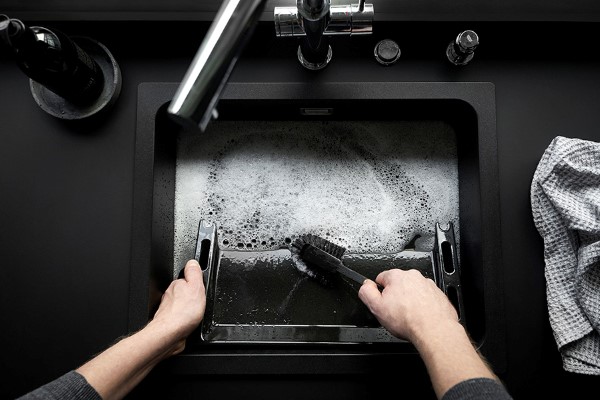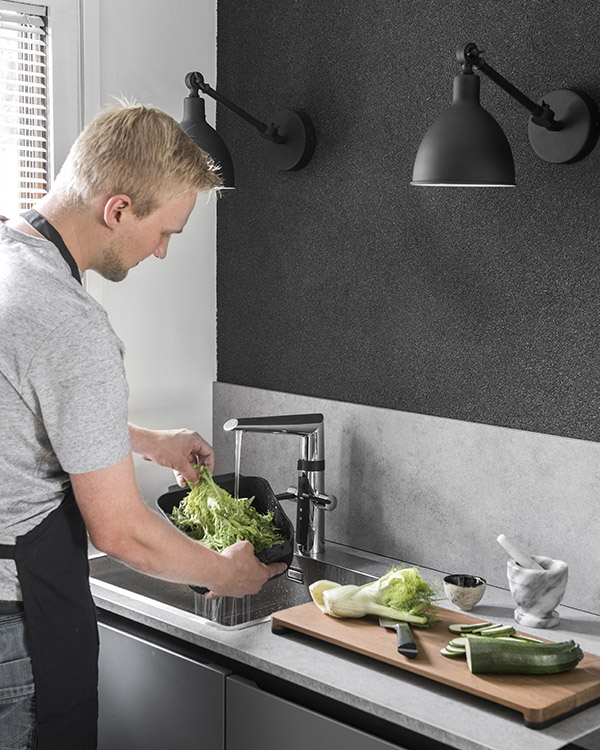How do you choose the right sink?
The sink together with the tap is the most used area in the kitchen. That is why the choice should be made with thought to match your personal needs. Stala has a wide selection of sinks and worktops to offer alternatives for all tastes and purposes. But which things should be paid attention to when designig a kitchen?
Do you handle large plates and kitchen equipment and prefer to wash dishes by hand?
“If you often wash dishes by hand and handle large dishes and kitchen utensils, it is going to affect the size of the bowl and even the number of bowls you need. For others, a small sink will be sufficient, while others might need a maxi-sized sink to even fit whole baking trays”, Peltonen describes.
At the summer cottage or when dishwashing by hand it is convenient to have two bowls, while those who cook a lot can appreciate a one and a half bowl sink. If you like to bake or cook with meat and fish, a kitchen worktop with plenty of hygienic stainless steel working surface is a convenient and safe choice. A worktop can be chosen with a raised edge profile, which keeps water on the counter instead of flowing onto the floor.
What to consider while choosing a counter top material and sink?
When you have identified your kitchen needs and habits, it is sensible to also consider the other countertop material for the kitchen. With sinks, our materials stainless steel and quartz composite are both durable and long-lasting choices for a kitchen. Your own taste is best to be used with the choice of these two.
If you choose a laminate or wood countertop material, a sink with a tap area would be the best choice, since mounting the tap straight onto wood or laminate can create risk with moisture. It is also worthwhile to have at least some stainless steel drainage area or working surface next to the bowl, since wood is not the best material to withstand splatters of water and setting wet dishes on.

Kitchen Sinks: How to Choose the Best Style for Your Needs
However, with so many styles to choose from, are homeowners choosing style over function? How can you determine which type of kitchen sink is best for your needs? Freshome asked experts from Kohler, Moen, Delta and Franke Kitchen Systems for tips on understanding the function of various kitchen sink styles.
The aesthetic appeal of the kitchen sink
“With the evolving role of the kitchen leading to tasks beyond traditional cooking and cleaning, people are often selecting more secondary sinks,” explains Peggy Gallagher, Senior Product Manager at Delta. When choosing the right sink, Gallagher tells Freshome that there are several factors to consider, but she believes style is the main driver.
“The sink is the workhorse of the kitchen,” according to Chris Nealon, Product Manager of Disposals and Sinks at Moen. “From making morning coffee to scrubbing dishes at night, not to mention all of the hand washing, cup filling and cleaning that goes on in between, the faucet and sink area see a lot of traffic every day.” With so much going on, Nealon tells Freshome that it’s important to find a kitchen sink that fits homeowners’ needs while still providing an appealing aesthetic.
Kitchen sink styles
“Large, single-bowl designs are convenient for washing oversize cookware, while dual-bowl sinks allow for quick wash-ups and offer multi-tasking functionality for the home chef,” Nealon says.
“Regarding design, undermount sinks offer an appealing aesthetic, make cleanup a breeze and are the ideal complement to popular natural stone and solid surface countertops,” Nealon explains. “The exposed front wall of farmhouse sinks complements traditional kitchens well, whereas drop-in sinks offer added convenience with a quick and easy installation process,” he says.

Choosing a Kitchen Sink: Things You Need to Know
Do you know the hidden benefits (and pitfalls) of choosing a single bowl or a double bowl? Do you know your farmhouse from your under-mount (or the difference between the two)? Or which finish has the final say in quality? We got to the bottom of the bowl to give you everything you need to know on sinks.
The trifecta of style: There are three main bowl styles: farmhouse, top-mount, and under-mount.
Farmhouse bowls: While great for accommodating large dishware and minimizing splashing, these are heavier and may require a special base cabinet for installation.
Top-mount bowls: These are characterized by the “drop-in” rim that holds the sink in place on the countertop. The rim makes this type of sink easy to install, but also makes it easier for dirt to accumulate.
Under-mount sinks: They look more sleek and modern, but often take double the installation time compared with top-mount sinks.

How to Choose a Kitchen Sink
Few of us today find ourselves chained to our kitchen sinks, washing up the dishes (thanks to our dishwashers), and yet the sink still plays a vital role within the modern-day kitchen. Thinking about how you use a sink on a daily basis – and perhaps how sinks in previous homes have met or failed to meet your needs – is a good place to start when thinking about buying new. But the aesthetic a sink brings to the kitchen interior scheme is also a priority — the sink is after all a feature in its own right.
Size and bowl configuration are among the first considerations.
If a sink is used very sparingly for tasks such as washing up, a single bowl (or ‘1.0’) may suffice. Single bowls are a good option for utility and/or boot rooms, and for kitchens short on surface space.
Many homeowners opt for 1.5 bowls and even two, which provide greater flexibility when it comes to tasks such as tipping away excess drinks whilst washing up, or for peeling vegetables.
Fitting the sink
Do look at a product’s ‘minimum cabinet size’ whilst specifying too. “Most sinks will fit within a 600mm cabinet, but it’s always worth checking as some sinks may require a larger cabinet size, even as large as 1,000mm,” says Rangemaster’s Paul Scarborough. This is particularly key when retrofitting a new sink where the units and worktop will remain.
Tap holes
Bear in mind that some inset models may come complete with one or more pre-drilled holes to accommodate a tap — ideal if you don’t have clearance or wall space behind to mount a tap, but far from perfect when the circular hole won’t accommodate your new square tap
Undercoating
Look to see if your chosen model comes with an undercoating, which is applied to a sink’s underside. “A good undercoat provides great sound insulation and will therefore prevent your sink from making too much noise when washing bulky items such as pots and pans. It can also prevent condensation build-up on the base of the sink,” explains Luke Shipway of Caple.

How to Choose the Right Stainless-Steel Kitchen Sink
Stainless steel scores plenty of brownie points for being an exceptional material for kitchen sinks. There are many different sink styles and materials available today and stainless steel is by far the most popular and common. If stainless steel is your material of choice for your new kitchen sink, then there are a few things you will need to consider that will help to narrow down your choices in shape, size and style
What is stainless steel?
Stainless steel is an alloy (or mix) of steel, chromium and nickel. Two details to look out for when selecting a good quality stainless-steel sink are the grade and the gauge of the stainless steel. The higher the percentage of chromium and nickel elements, the better the grade of stainless steel.
Why choose stainless steel?
Stainless steel is the most common choice for kitchen sinks and with good reason. It’s a very durable material, which is easy to clean and requires very little upkeep.
Type: Top-mount sink
When you are choosing a stainless-steel sink for your new kitchen, the two most common installation options that you will be offered are under-mount and top-mount.
A top-mount sink, also referred to as an inset sink, is the more cost-effective option, both in terms of retail cost and the cost associated with installation. The outer rim of the sink sits on top of the bench, such as the one pictured here. These sinks usually have a stainless-steel drainer board attached, although you can choose to have one without.